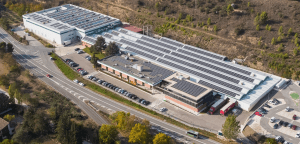At Schneider Electric we have been working to reduce the IT carbon footprint for several years now. We used comprehensive Green IT program that measures, manages, and mitigates the impact of IT. Check out my previous blogs if you want to know more about the fundamentals of our IT-led strategy, and our structural approach to IT end user devices.
In this blog, I will be focusing on the usage of our own solutions to run IT infrastructure assets more efficiently and accelerating moving to the cloud, as part of an integrated sustainable Green IT strategy.
Greener data centers as a key component of a sustainable business approach
Managing IT energy efficiency is crucial, considering the significant power consumption of data centers worldwide. According to Forbes, approximately 3% of all electricity generated on Earth is used to run data centers. This highlights the importance of making data centers more efficient and to incorporate sustainable practices in this area to reduce carbon emissions. If your company doesn’t operate own data centers and relies on colocation or cloud services, you should choose providers that prioritize renewable energy sources and energy efficient data centers. This choice is essential to support your sustainability efforts and reduce the environmental impact of your company’s data storage and processing.
EcoStruxure IT is our solution for optimizing IT infrastructure management. It leverages IoT-enabled hardware, software, and services to offer real-time data insights, proactive monitoring, and remote management capabilities for critical IT environments, including data centers. Since 2018, Schneider Electric’s solutions, including EcoStruxure IT, have helped our customers save and avoid 513 million Tonnes of CO2 emissions. That’s equivalent to the average annual emissions of almost 18K commercial airliners! If we’re committed to reducing our customers’ emissions, doesn’t it make sense to apply our own solutions to minimize our own digital footprint too?
Experiencing our own products firsthand
A few years ago, we began our green IT journey and incorporating our own solutions which can measure real-time IT energy loads and emissions. EcoStruxure IT DCIM help us manage our IT environments more effectively. It allowed us to evolve from using secondary data such as manufacturing profiles to estimate energy emissions, to real-time primary data readings.
The first step to reduce CO2 emissions is to establish a fact-based baseline. This has provided significant improvements in measuring our own energy consumption and emissions over time. As we move forward with strategies like virtualization, technical debt reduction, and cloud migration, EcoStruxure IT also enables us to assess our progress in reducing emissions. Let’s take a look at a couple of examples:
- In our Boston, MA, headquarters, the energy emissions from IT operations experienced an 11% reduction last month compared to the 2022-2023 average monthly emissions.
- Our Lexington Smart Factory site located in Kentucky (USA) achieved an impressive reduction of 34% within the same timeframe and scope.
As companies prepare for upcoming regulations like the EU Energy Efficiency Directive which mandates the reporting of IT energy consumption starting May 15, 2024, the significance of accessing real-time primary data becomes even more critical. This data will play a vital role in complying with the requirements and ensuring accurate reporting.

Move to cloud – a move towards sustainability
According to Accenture, moving to the public cloud can reduce 59 million tons of CO2 per year, which is a 5.9% reduction in total IT emissions. By achieving reductions like these, businesses can be closer to meeting their climate change commitments. Let’s take a look at the benefits cloud computing offers to sustainable IT:
- Energy efficiency: consolidating data center infrastructure improves resource utilization, leading to reduced energy consumption compared to individual on-premises centers.
- Server virtualization: hardware resources are optimized by running multiple virtual machines on a single physical server.
- Dynamic resource allocation: cloud environments enable dynamic resource allocation based on demand, minimizing energy waste from underutilized hardware.
- Shared infrastructure: cloud services facilitate resource sharing among users, enhancing efficiency and reducing environmental impact.
- Reduced hardware waste: by reducing reliance on physical hardware, organizations minimize electronic waste from obsolete equipment disposal.
According to the International Communication Union (ITU), a yearly reduction of 4.2% in emissions within the Information and Communication Technology (ICT) sector is suggested. As part of our cloud migration strategy and following these standards, we have set a goal to achieve a 5% reduction in the usage of cloud storage data annually until 2027. In this sense, we decreased energy-related emissions by 30% for on-premises servers last year, equivalent to a reduction of 2,162 T of CO2e.
If you are a tech leader in a data center industry or simply trying to report on the data center operations of your company, check out this whitepaper in which we propose 5 categories for environmental sustainability reporting metrics.




Add a comment